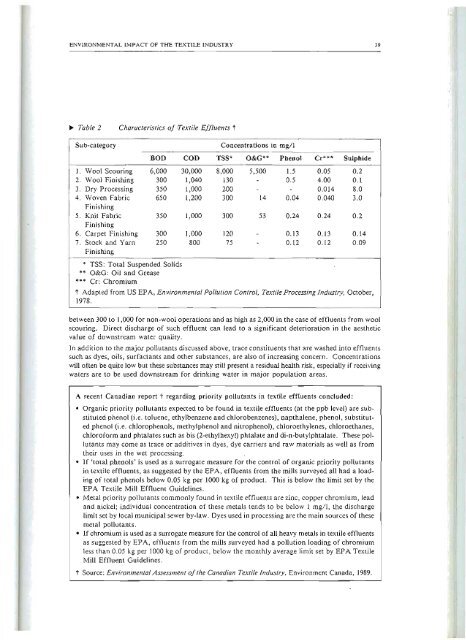Contributor, The Textile Industry and the Environment, UNEP
Contributor, The Textile Industry and the Environment, UNEP
Contributor, The Textile Industry and the Environment, UNEP
You also want an ePaper? Increase the reach of your titles
YUMPU automatically turns print PDFs into web optimized ePapers that Google loves.
ENVIRONMENTAL IMPACT OF THE TEXTILE INDUSTRY 39<br />
II> Table 2 Characteristics of <strong>Textile</strong> Effluents t<br />
Sub-category COllcentrations in mg/I<br />
BOD COD TSS* O&G** Phenol Cr*** Sulphide<br />
1. Wool Scouring 6,000 30,000 8,000 5,500 1.5 0.05 0.2<br />
2. Wool Fioisrung 300 1,040 130 0.5 4.00 0.1<br />
3. Dry Processing 350 1,000 200 0.014 8.0<br />
4. Woven Fabric 650 1,200 300 14 0.04 0.040 3.0<br />
Finishing<br />
5. Knit Fabric 350 1,000 300 53 0.24 0.24 0.2<br />
Finishing<br />
6. Carpet Finishing 300 1,000 120 0.13 0.13 0.14<br />
7. Stock <strong>and</strong> Yarn 250 800 75 0.12 0.12 0.09<br />
Finishing<br />
>I< TSS: Total Suspended Solids<br />
** 0&0: Oil <strong>and</strong> Grease<br />
*** Cr: Chromium<br />
t Adapted from US EPA, <strong>Environment</strong>al Pollution Control, <strong>Textile</strong> Processing <strong>Industry</strong>, October,<br />
1978.<br />
between 300 to 1,000 for non-wool operations <strong>and</strong> as high as 2,000 in <strong>the</strong> case of effluents from wool<br />
scouring. Direct discharge of such effluent can lead to a significant deterioration in <strong>the</strong> aes<strong>the</strong>tic<br />
value of downstream water quality.<br />
In addition to <strong>the</strong> major pollutants discussed above, trace constituents that are washed into eftluencs<br />
such as dyes, oils, surfactants <strong>and</strong> o<strong>the</strong>r substances, are also of increasing concern. Concentrations<br />
will often be quite low but <strong>the</strong>se substances may still present a residual health risk, especially if receiving<br />
waters are to be used downstream for drinking water in major population areas.<br />
A recent CanadiaJ.l repol1 t regarding priority pollutants in textile effluents concluded:<br />
.. Organic priority pollutants expected to be found in textile effluents (at <strong>the</strong> ppb level) are substituted<br />
phenol (i .e. toluene, ethylbenzene <strong>and</strong> chlorobenzenes), oapthalene, phenol, substituted<br />
phenol (i.e. chlorophenols, methylphenol <strong>and</strong> nitrophenol), chloroethyJenes, chloroethanes,<br />
chloroform <strong>and</strong> phtaJates such as bis (2-ethylhexyl) phtalate <strong>and</strong> di-n-butylphtalate. <strong>The</strong>se pollutants<br />
may come as trace or additives in dyes, dye carriers <strong>and</strong> raw materials as well as from<br />
<strong>the</strong>ir uses in <strong>the</strong> wet processing.<br />
.. If 'total phenols' is used as a surrogate measure for <strong>the</strong> control of organic priority pollutants<br />
in textile effluents, as suggested by <strong>the</strong> EPA, effluents from <strong>the</strong> mills surveyed all had a loading<br />
of total phenols below 0.05 kg per 1000 kg of product. This is below <strong>the</strong> limit set by <strong>the</strong><br />
EPA <strong>Textile</strong> Mill Effluent Guidelines.<br />
• Metal pdority pollutants commonly found in textile effluents are zinc, copper chromium, lead<br />
<strong>and</strong> nickel; individual concentration of <strong>the</strong>se metals tends to be below 1 mg/I, <strong>the</strong> discharge<br />
limit set by local municipal sewer by-law. Dyes used in processing are <strong>the</strong> main sources of <strong>the</strong>se<br />
metal pollutants.<br />
• If chromium is used as a surrogate measure for <strong>the</strong> control of aU heavy metals in textile efOuents<br />
as suggested by EPA, effluents from <strong>the</strong> mills surveyed had a pollution loading of chromium<br />
less than 0.05 kg per 1000 kg of product, below <strong>the</strong> monthly average limit set by EPA <strong>Textile</strong><br />
Mill Effluent Guidelines.<br />
t Source: <strong>Environment</strong>al Assessment oj<strong>the</strong> Canadian <strong>Textile</strong> <strong>Industry</strong>, <strong>Environment</strong> Canada, 1989.

















